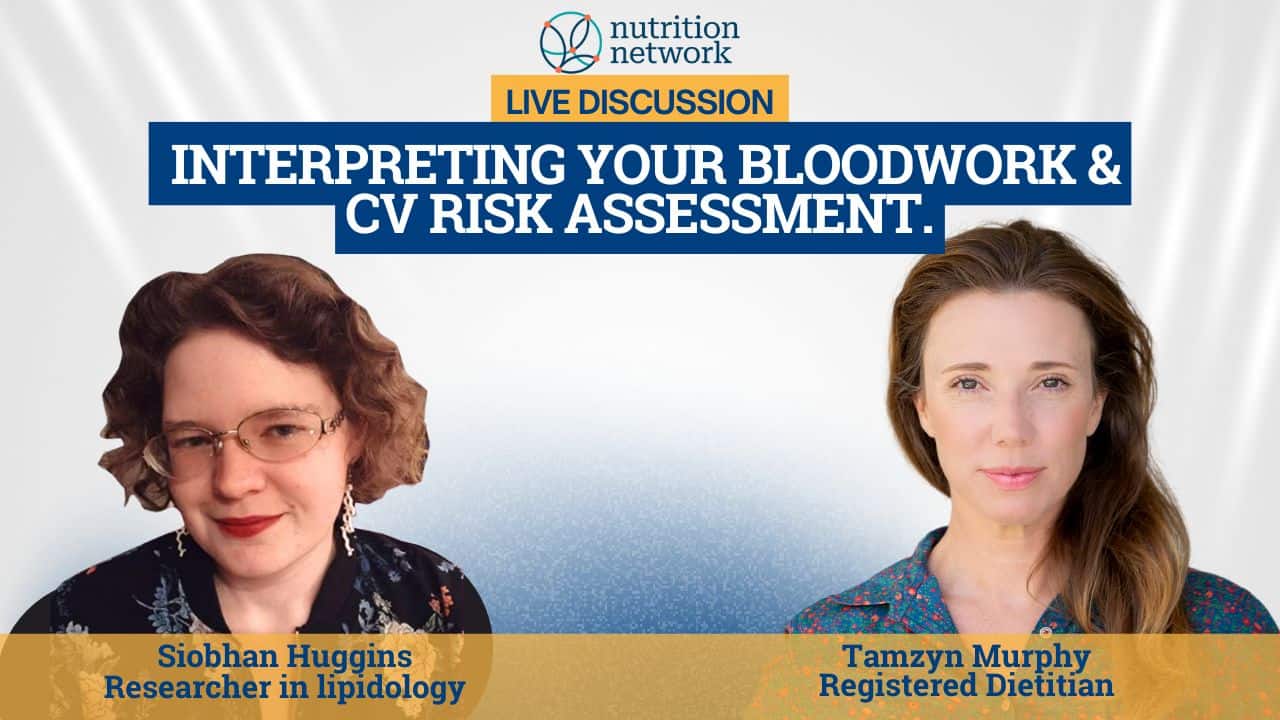Featuring Siobhan Huggins and Tamzyn Murphy, RD, MSc
Live Interview Recap | Mastering Metabolic Metrics Training (Launching 30 July)
“If you don’t know what’s wrong, then you can’t fix it.”
That was how Tamzyn Murphy, registered dietitian and Head of Content at Nutrition Network, opened a fascinating Live session with metabolic health researcher and ketogenic veteran, Siobhan Huggins. The topic? Interpreting lab results in the context of therapeutic carbohydrate restriction (TCR)—including low-carb, ketogenic, and carnivore diets.
The session offered a sneak peek into the upcoming Mastering Metabolic Metrics training (launching 30 July in collaboration with Keto-Mojo), and provided clarity around a question that many clinicians and patients alike are grappling with: what do your lab results really mean on a low-carb diet?
Why “Normal” Lab Ranges Might Not Be Normal, for You
“If you’re doing keto, low-carb, or carnivore, your lab results may not look like what a textbook says they should. That doesn’t always mean something’s wrong,” said Huggins.
The core issue? Most lab reference ranges are based on average populations—many of whom are metabolically unhealthy. “There’s no keto- or carnivore-specific reference range,” she explained, “so interpreting results without context can lead to unnecessary worry, or worse, misdiagnosis.”
For example, many labs list fasting insulin as ‘normal’ up to 25 µIU/mL. But in the context of metabolic health, Huggins notes that “a functional reference range—cutting off at 5.5—makes a lot more sense.”
Preparation Is Everything: The Do’s and Don’ts Before a Blood Draw
Huggins emphasized that what you do before the blood test can influence what shows up on your results. And this is especially true for those following a TCR approach.
Here’s what she recommends:
- Follow your usual diet (3–5 days beforehand). No cheat meals or extended fasts.
- Fast for 12–16 hours water-only before the test. “That means no coffee—even black,” she cautioned, because caffeine is lipolytic and can spike triglycerides.
- Avoid high-intensity exercise for 7 days before testing. Muscle breakdown can raise liver enzymes (ALT, AST), mimicking liver pathology like fatty liver.
- Stop high-dose biotin (often found in multivitamins or B-complexes) at least 72 hours prior. It can skew thyroid and insulin test results.
“It’s amazing to me how few clinicians actually warn patients about this,” Tamzyn remarked. “They just say ‘don’t eat or drink from the night before.’”
Lipid Panel on Keto: A Whole Different Beast
The most controversial laboratory parameter on a low carbohydrate diet is arguably the lipid panel. On keto and carnivore diets, triglycerides typically drop and HDL rises—markers most clinicians cheer for. But LDL often goes up too, which is where the fear kicks in.
“We’ve been conditioned to think ‘high LDL equals high risk,’” said Tamzyn, “but is that really true in this context?”
Huggins explained that LDL may rise significantly in lean individuals on very low-carb diets, especially when paired with low body fat. This profile is called a Lean Mass Hyper-Responder (LMHR) and is characterized by:
- LDL > 200 mg/dL (> 5 mmol/L)
- HDL > 80 mg/dL (> 2 mmol/L)
- Triglycerides < 70 mg/dL (<0.8 mmol/L)
Is it dangerous? “We don’t fully know yet,” Huggins admitted. “The Lean Mass Hyper-Responder study is looking into it now with CT angiograms and calcium scans, but it’s ongoing.”
Some LMHRs choose to reintroduce small amounts of carbohydrates or use medications like cholesterol absorption inhibitors. Others monitor with imaging tools like CAC (coronary artery calcium) scans or CIMT (carotid intima-media thickness) ultrasounds to track real cardiovascular risk over time.
Tamzyn added, “What’s exciting is that the Mastering Metabolic Metrics training gives clinicians the tools to assess risk using both lab work and imaging. Because it’s not just about numbers—it’s about what’s really happening in the arteries.”
ApoB, LDL-P, and Particle Size: Should You Be Worried?
What about ApoB and LDL particle count—metrics often seen as better indicators of cardiovascular risk?
“ApoB doesn’t differentiate between remnant particles and LDL,” Huggins clarified. “In metabolically unhealthy people with high triglycerides, the remnants are a concern. But if someone has low TG, high HDL, and high LDL, is high ApoB still a red flag? We don’t know.”
Similarly, LDL particle size—large, buoyant vs small, dense—is often discussed. But Huggins notes that with a standard lipid panel, you can reasonably estimate particle size: “If HDL is high and TG is low, LDL-P will likely be proportionate to LDL-C.”
Fasting Glucose and HbA1c: A Hidden Curveball
One surprising finding in some low-carb individuals? Elevated fasting glucose and HbA1c—despite excellent insulin sensitivity and flat CGM (continuous glucose monitor) readings.
“It’s called adaptive glucose sparing,” explained Huggins. “The body prioritizes fat as fuel and becomes less reliant on glucose. The cells begin rejecting glucose—not out of dysfunction, but by design.”
This can result in a steady but slightly elevated glucose level, especially in lean, high-protein carnivore eaters.
Tamzyn asked, “Should people on keto or carnivore diets be worried if their HbA1c is somewhat raised?”
“We don’t have enough data,” Huggins replied, “but there’s a comparable group—people with glucokinase mutations—who have steady elevated glucose without increased vascular risk.”
Still, if concerned, individuals can:
- Increase fat intake (and reduce protein)
- Reintroduce small amounts of carbohydrates
- Monitor with CGM or tests like fructosamine
Oral Glucose Tolerance Tests (OGTTs): Do They Work on Keto?
Short answer: no.
A low-carb dieter may fail an OGTT, not due to insulin resistance, but due to a loss of first-phase insulin response—a normal adaptation to fat-based fueling.
“I’ve seen many pregnant women refuse the OGTT and instead track post-meal glucose from their normal meals—and doctors are fine with that,” Huggins shared.
She added: “If someone really wants to do an OGTT, they should carb-load for 3 days first to restore insulin priming.”
Nutrient Testing: What’s Real and What’s a Red Herring?
What about vitamins and minerals on a carnivore diet?
Vitamin C
Despite myths, muscle meat contains vitamin C—enough to prevent deficiency unless cooking is excessive. “Amber O’Hearn’s work shows that increased carnitine intake may even spare vitamin C,” said Huggins.
Folate
Folate shouldn’t be deficient on carbohydrate restricted diets as gut bacteria upregulate folate production in low-carb eaters. If folate is low, look for:
- Gut dysbiosis
- Chronic inflammation
- Not enough organ meat (in some cases)
Electrolytes
During keto adaptation, electrolytes can fluctuate due to fluid loss. Watch for:
- Headaches
- Muscle cramps
- Fatigue
Use the anion gap on a CMP panel as a marker.
Carnitine & Selenium
On very high-fat diets (>80% fat), monitor:
- Carnitine (especially if also on medications like anti-epileptics)
- Selenium (may be low if animal protein is too restricted)
Final Thoughts: Testing Smarter, Not Harder
Siobhan’s key takeaway? Context is everything.
“If a patient feels amazing but their lab work looks unusual—ask why. And if a patient feels awful and their labs are ‘normal’—ask why again,” she said.
Her favorite markers?
- Lipoprotein(a): A genetically determined marker of heart disease risk—she’ll be covering this in-depth in Nutrition Network’s upcoming Cardiovascular training (email support@nutrition-network.org to pre-book your spot on this training).
- GlycA: “It’s super stable and pairs well with CRP to assess inflammation. If CRP is high but GlycA is low, it may just be due to a cold or a workout.”
Why You Need the Mastering Metabolic Metrics Training
This Live session was just the tip of the iceberg. If you’re a clinician, coach, or even a health-conscious individual trying to make sense of your own lab results, this training is essential.
Launching 30 July by Nutrition Network in collaboration with Keto-Mojo, the Mastering Metabolic Metrics course gives you:
- In-depth lectures from Siobhan Huggins, Dr. Matthew Budoff, Dr. Hassina Kajee, Franziska Spritzler, Peter Cummings, Beth McNally, Dr Neville Wellington and more.
- Expert guidance on interpreting ketones, glucose, insulin, GKI, lipids, thyroid, nutrient levels, inflammation markers, and wearable data
- Clinical tools, validated questionnaires, and blood test protocols
✅ Enroll now – https://nutrition-network.org/online-training/testing-tracking-and-diagnostics/
Use early bird code before 30 July for 30% off
Questions? Email: support@nutrition-network.org
Whether you’re managing metabolic syndrome, optimizing athletic performance, or simply trying to understand your own labs, this training will give you the clarity, confidence, and clinical edge you need.
Because in metabolic health, numbers don’t lie—but they do need interpretation.










